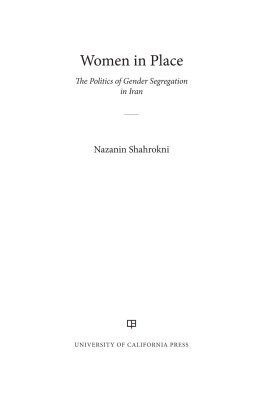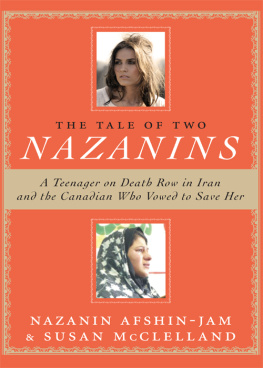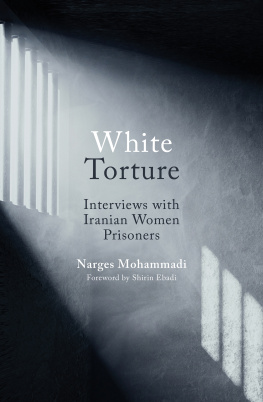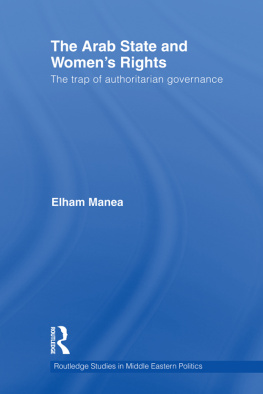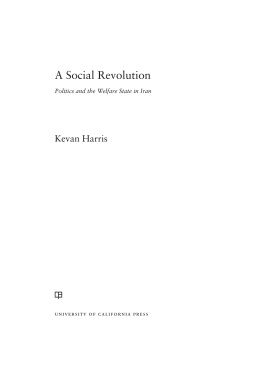Women in Place
Women in Place
The Politics of Gender Segregation in Iran

Nazanin Shahrokni

UNIVERSITY OF CALIFORNIA PRESS
University of California Press
Oakland, California
2020 by Nazanin Shahrokni
Library of Congress Cataloging-in-Publication Data
Names: Shahrokni, Nazanin, author.
Title: Women in place : the politics of gender segregation in Iran / Nazanin Shahrokni.
Description: Oakland, California : University of California Press, [2020]
Identifiers: LCCN 2019023565 (print) | LCCN 2019023566 (ebook) | ISBN 9780520304277 (cloth) | ISBN 9780520304284 (paperback) | ISBN 9780520973008 (ebook)
Subjects: LCSH : Muslim womenGovernment policyIran. |
Discrimination in public accommodationsIran.
Classification: LCC HQ 1735.2 S 534 2020 (print) | LCC HQ 1735.2 (ebook) | DDC 305.48/6970955dc23
LC record available at https://lccn.loc.gov/2019023565
LC ebook record available at https://lccn.loc.gov/2019023566
Manufactured in the United States of America
28 28 27 26 25 24 23 22 21 20
10 9 8 7 6 5 4 3 2 1
Contents
Illustrations
FIGURES
TABLES
Preface and Acknowledgments
A story has no beginning or end: arbitrarily one chooses that moment of experience from which to look back or from which to look ahead.
GRAHAM GREENE , 1951
I can trace that moment all the way back to a hot summer afternoon on July 30, 1995, in Isfahan. There were twenty-five hundred of us: women athletes from universities across Iran. Wrapped up in our school uniforms of black scarves and long, loose, dark dresses, we were indistinguishable, like a flock of dark-feathered birds. Excited to have flown all the way from Tehran, the capital, to Isfahan to attend the Second Students Sports Olympiad, we marched toward Piroozi Sports Complex to attend the opening ceremony. The boys were already seated inside. We could hear the sound of their drums, whistles, and chants as we stood outside sweating, waiting in line to get inside from the back door, the womens entrance, located in a small alley too narrow to contain the restlessness of our wings. One by one we had to pass through what I called the tunnel of horror. A few members of the organizing committee, including Parvaneh Nazarali, the head of Womens Sports, had formed a tunnel-like passage. Wrapped up in their long black chadors, their frowning faces were all we could see, their eyes searching for immodest suspects. As we passed through the entrance, we were presented with a long list of not-to-dos: Do not laugh out loud!; Do not whistle and chant!; Do not talk to the boys!
Inside the stadium, after what seemed like the longest hour of my life, we were guided toward our section, the womens section. I slouched on my seat and scanned my surroundings. Most of my teammates, Shahid Beheshti University volleyball players, were ecstatic, grasping every opportunity to do what they had been told not to do: as the disciplining gaze of the officials moved away, the girls would whistle, clap, chant, and even do a few dance moves; as the gaze moved back they would stop, as if they were playing freeze dance. Ironically, the restrictions had added an extra layer of excitement. What to me was a source of humiliation, to many of my teammates was a source of hilarity. For me there was pain in playing by the rules; for them there was pleasure in playing with the rules.
These were my thoughts when Guity Shambayati, who had a habit of taking my inquiring mind and critical words seriously, encouraged me to write my first piece for Zanan magazine, then the most reputable feminist monthly in Iran. Soon after its submission, Shahla Sherkat, the editor, called me on the phone and asked if I wanted to become a journalist. In 1996 I officially joined Zanan. It was Shahla Sherkat, not my first-grade teacher, who taught me how to write. That small room in Ziba Street, from which Zanan operated, is where I thrived as a writer.
Throughout years, mockery of the rules, such as my teammates playing freeze dance, and hide and seek with the officials, made many of these rules and bans essentially ineffective. In 2008, when I attended a (mens) basketball game between two of Irans leading teams and sat next to a female guard at the womens section, she complimented me on my appropriate look and manners. Age might have made my manners appear more lady-likeafter all, thirteen years had passed, and I was the product of the gaze that had for years regulated my appearance and bodily movementsbut at the same time, I was wearing a white scarf, loosely tied with a knot under my chin, with a portion of my hair uncovered, and a blue tunic style dress with jeans. With this outfit, I would not have passed the propriety test back in 1995. When the young woman next to me started jumping up and down, chanting with excitement as her favorite team scored points, the female guard looked at me, shrugged her shoulders, and said: The youth these days are out of control! What can I do? Its a basketball game after all! A compromise, perhaps, which was the flip side of rules not taken seriously for decades.
In the years that followed the Second Students Sports Olympiad, Parvaneh Nazarali and her colleagues at different state offices continued to hurdle over various obstacles in the masculinist (and Islamist) domains of sports and the state in their efforts to promote womens access to public spaces, particularly to sporting events and opportunities. To them, I learned later, the door at the end of that small alley in Isfahan signified a delta that would open up to an ocean of opportunity. What I and many others labeled as a space of proscription was to them a space of possibility that they had fought very hard to carve out. The inclusion of women athletes in the opening ceremony had come at a cost, and they were determined to maintain this success, come what may. The few strands of hair sticking out of our long black scarves, in their view, did not just undermine Islamic propriety but also made them susceptible to harsh criticism from their male peers and superiors, which could potentially jeopardize the future of womens sports and their further access to public facilities. The villains (heroes?) of the opening vignette, I realized, were themselves; caught up in a giant web of rules and regulations, they had to navigate a perilous route between ideological imperatives and political skirmishes and practicalities. This realization, along with the unique insights of Hosein Ghazian, Zanans adviser and a sociologist, inspired in me the desire not to fall into facile assumptions but to dig deeper, beyond the obvious, and compelled me to pursue a postgraduate degree in sociology, not chemistry, which I had majored in. My life as a sociologist thus started at Allameh Tabatabai University in Tehran, where I was immersed in a fascinating new adventure of discovery and became well versed in the alphabets of social science.
But that intellectual journey soon took me outside Iran. First I went to Montreal, Canada, where I was embraced by Homa Shams and Enayat Shahrokni, my aunt and uncle, who created a home away from home and facilitated my transition to North America. My conversations with Shirin Shahrokni and Karoline Truchon were, and continue to be, elevating. At Concordia University, Homa Hoodfar, whom I had met at an SSRC workshop on cities and citizenships in the Middle East in Beirut in 2001, provided me with research opportunities and opened doors for me as I applied for PhD programs. At that same workshop, I had met Norma Claire Moruzzi, Kaveh Ehsani, and Arang Keshavarzian, who have ever since watched over me and ceaselessly offered their wisdom, friendship, and support. This mentoring team represents to me the best that academia has to offer. They are a model of academic rigor, integrity, care, comradery, and tutelage. Such a rarity!
Next page
